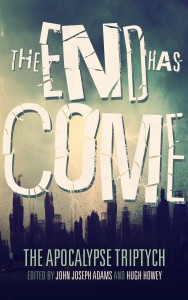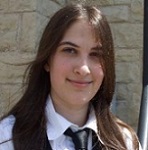
Buy The End Has Come, edited by John Joseph Adams and Hugh Howey
In collaboration with editors John Joseph Adams and Hugh Howey, A Dribble of Ink is proud to introduce a series of interviews with the authors of The End Has Come, the final volume in the The Apocalypse Triptych. Following on The End is Nigh, and The End Is Here, The End Has Come contains 23 stories about life after the apocalypse.
Interview with Megan Arkenberg about “Like All Beautiful Places”
(Interview by Lauren Smith)
Tell us about your story, “Like All Beautiful Places”.
“Like All Beautiful Places” follows the environmental catastrophes that began in “Houses Without Air” and “Twilight of the Music Machines.” After earthquakes and toxic rain devastate San Francisco, a small group of survivors attempts to reconstruct the city in an immersive alternate reality. Grecia, the narrator, struggles with her role in the project—and, more broadly, with her place in the world, now that she’s freed from the consequences of a series of disastrous personal decisions.
In an interview with Nightmare Magazine, you spoke about the need for well-defined settings to engage readers, and said your settings often play active roles in the plot. With this in mind, why did you choose San Francisco?
There’s a couple answers to this. The easy one is that I started drafting this story while house-sitting in San Francisco (which was also when and where I wrote the majority of my previous Triptych story, “Twilight of the Music Machines). Some of my other fiction has addressed the parts of the city that I loved, but Grecia gave me the chance to vent about the aspects that irritated me. I also thought the setting was thematically appropriate; if Washington D.C. was the perfect place for a memorial in “Houses Without Air,” then the ridiculously iconic San Francisco seems like a good image for memory and representation.
Your protagonist, Grecia, is helping preserve the memory of a city she didn’t like, where she lived with a guy she hated, and it’s sometimes physically painful for her to do this. So why is she doing it?
I think the immersive alternate reality project is giving her the chance to claim her experiences for herself. Now that she’s separated from the people and circumstances that made her unhappy, she’s able to re-evaluate her own role in her history, to connect these events to herself and her choices instead of all these outside influences.
“Like All Beautiful Places” and your other stories in the Apocalypse Triptych are all structured according to a number of things: seven matches (a reference to “The Little Matchgirl” fairy tale); six music tracks; and now a count to five (as in, count to five and say what your heart wants). Seven, six, five – an apocalyptic countdown?
I guess I’d say it’s a pattern rather than a countdown—it isn’t meant to inspire dread or anything! For all three stories, the counted motif is part of something integral to the narrative (the memorial, music, and Grecia’s decision, respectively). But I also needed the structure to help me pull together all the distinct segments of the stories. The Triptych gave me the chance to develop several facets of both this apocalyptic world and the particular characters in each story, and the counted segments helped me fit these facets together in a coherent way.
One of the first things I noticed about Grecia is that the apocalypse is useful to her, in that it helps her escape a toxic relationship. Your other Apocalypse Triptych protagonists also find personal advantages to the world ending – not having to bother keeping in touch with people, not having to deal with failing to graduate from high school. What kind of emotional appeal would you say the apocalypse presents?
That’s a great observation. In an interview for Wastelands 2, I mentioned that the apocalyptic genre often strikes me as pastoral, in that it represents an escape from the stress and complications of contemporary life. I think that comes through more clearly in my Triptych stories than in my other apocalyptic fiction; to varying degrees, Beth and Farah, Friday and Cloud, and Grecia and Lena are taking advantage of the end of the world to create new realities for themselves, in circumstances of their choosing.

About Megan Arkenberg
Megan Arkenberg lives and writes in California. Her short stories have appeared in Lightspeed, Asimov’s, Strange Horizons, and dozens of other places. She procrastinates by editing the fantasy e-zine Mirror Dance.
About the anthology
Famine. Death. War. Pestilence. These are the harbingers of the biblical apocalypse, of the End of the World. In science fiction, the end is triggered by less figurative means: nuclear holocaust, biological warfare/pandemic, ecological disaster, or cosmological cataclysm.
But before any catastrophe, there are people who see it coming. During, there are heroes who fight against it. And after, there are the survivors who persevere and try to rebuild.
Edited by acclaimed anthologist John Joseph Adams and bestselling author Hugh Howey, The Apocalypse Triptych is a series of three anthologies of apocalyptic fiction. The End Is Nigh focuses on life before the apocalypse. The End is Now turns its attention to life during the apocalypse. And The End Has Come focuses on life after the apocalypse.
Buy the book
The End Has Come is available as a trade paperback or eBook.
